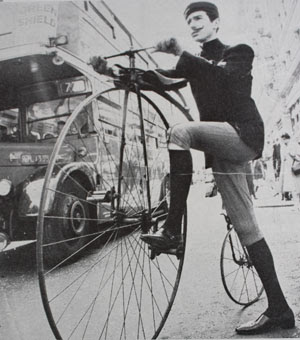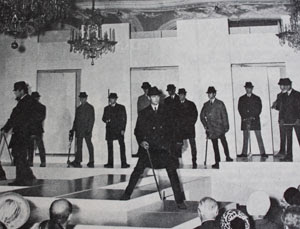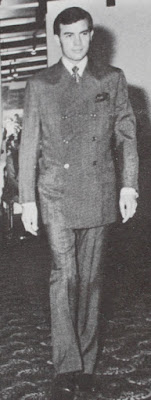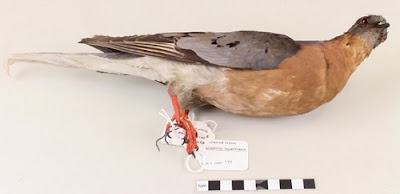 |
George Rutland riding a penny farthing on the street
in 1964 (Hepworth Mercury Archive) |
Do models care about what they wear? According
to George Rutland, one of Britain’s first top male models, they
absolutely do!
From penny farthing-riding plus fours to groovy
wide-leg flares with high-heeled boots to a canary yellow-coloured
suit, Rutland had the opportunity to wear a wonderful array of
fashionable clothing during his modelling career in the 1960s and
‘70s.
In a recent interview, conducted as part of a research
project exploring the fashion industry in Leeds during the post-war
period, the Bermuda-native confirmed that models do indeed take an
active interest in the pieces they showcase on the runway. Rutland
reminisces how he swelled with pride when walking down the catwalk in
a meticulously-tailored suit and firmly believes that a man never
looks or feels better than when he is wearing a classic suit.
 |
| Group of models (Hepworth Mercury Archive) |
Although
he initially came to England from Bermuda as an aspiring actor,
Rutland began modelling for Hepworths, a Leeds-based clothing
manufacturer, shortly before the company’s centenary in 1962. As
part of their fee, professional models received the suits they had
worn the previous season when they attended their annual fittings, so
Rutland amassed quite a sizeable wardrobe, including many bespoke
suits created by Savile Row designer Hardy Amies.
Rutland was so
pleased with the quality of these suits that he wore them every day,
not just on the runway. He was happily ‘plugging Hepworths the
whole time’. This commitment to maintaining an impeccable, suited
appearance proved highly beneficial for Rutland, as his Hardy Amies
Hepworth’s suit won him a film role and earned the approval of
esteemed photographer Sir Cecil Beaton. Rutland tells the story in
his own words here.
A very stylish man: Tony Armstrong-Barnes
Tony Armstrong-Barnes, Rutland’s
fellow model and close friend, received similar attention when
wearing Hardy Amies’ suits. Upon encountering photographers and
tailoring company executives around town, Barnes was often recognised
and complimented for his stylish apparel. He fondly recalls the time
that television producer Monty Berman saw him at the opera and
complimented the young model’s ability to wear a suit. Listen to
Barnes recount this moment here.
Unlike
Rutland, who later became a fashion show director, Barnes devoted
himself to professional modelling and worked for a number of
companies, including Hepworths, Burtons, Alexandre and Marks &
Spencer. Originally an aspiring dancer, who compares his childhood
dreams to those of Billy Elliot, Barnes unexpectedly began modelling
in the late 1950s after standing in for an ill friend at a photo
shoot for a knitting pattern cover.
 |
Tony Armstrong-Barnes, 1965
(Hepworth Mercury Archive) |
Due to the lack of young male
models during this period, as well as his good looks and charm,
Barnes quickly became sought-after by prominent London photographic
studios and developed a large portfolio. Some of his most significant
jobs included a Kellogg’s Corn Flakes box advertisement with Patty
Boyd (a famous model who later married both George Harrison and Eric
Clapton) and Burton’s 1964 photo ad (the first colour advertisement
in an English newspaper).
Since models of the era were responsible
for providing their own accessories and styling themselves at photo
shoots, Barnes acquired a vast wardrobe consisting chiefly of suits,
which he wore in his leisure time as well as to work. Indeed, he was
so accustomed to donning formalwear on a daily basis that he even
wore a pinstripe suit for his first meeting with photographer David
Bailey, who is best known for capturing casual images. Barnes briefly
describes this meeting here.
Due to changing fashions throughout his
career, Barnes had the opportunity to wear a diverse variety of
styles, ranging from the velvet suits of the Teddy Boys to the narrow
trousers of Mods. Perhaps since he was expected to appear in
contemporary fashions on the runway, Barnes preferred to imitate the
classic, tailored style of actors like Cary Grant and George Pepard
when selecting his private wardrobe. In contrast, his friend Rutland
always embraced the latest trends and relished wearing flares and
platforms in the 1970s. Rutland still laughs when he recalls tripping
in a particularly expensive pair of trendy, high-heeled boots. Listen
to this amusing anecdote here.
After more than 50 years in the fashion
industry, both Rutland and Barnes continue to maintain substantial
wardrobes that include starched cuffs, neckties, and waistcoats and,
of course, high-quality suits. After all, as Rutland confirms, ‘You
can’t get away from a classic man’s suit.’ Leeds Museums are
fortunate to have several such fine suits in their collections, some
of which will be on display in the newly re-developed tailoring
gallery at Armley Mills.
By Curatorial Intern Katherine Young
(Images: Hepworth Mercury Archive)












































